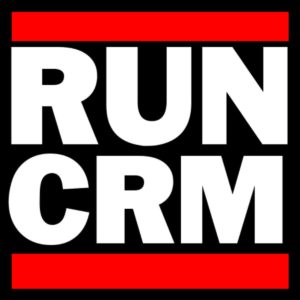Related sites:
Newsletter: Perspectives on Power Platform
Company: Niiranen Advisory Oy

Welcome to Thinking Forward - my new blog built on top of the foundation that was laid by Surviving CRM in 2008-2019. As we're approaching the turn of the decade, it's a great moment to push myself into more actively exploring the world beyond CRM.
In 2008 I started a blog called Surviving CRM. Now in 2019, 11 years later, it’s time to move on.
Don’t worry, I have no intention to stop blogging. Nor will there be a dramatic change in the type of content I’ll be posting or the topics I’ll be covering. This is merely a symbolic farewell to my blog’s original frame of reference, which was customer relationship management (CRM) and more specifically Microsoft Dynamics CRM as the technology for delivering solutions to bring the organization’s CRM strategy to life on a practical level.
While there is a benefit in having an established three letter acronym to describe what exactly you do for a living, I feel that just “doing CRM” has not been my focus area for quite some time now. I have spent far more time and energy in educating Dynamics customers and professionals why they need to think outside the familiar CRM box. This shift towards a broader Business Applications story had of course started already earlier with the app explosion of Dynamics 365 and the product’s tighter alignment with Office 365, but it was Microsoft’s launch of Power Platform in 2018 that really drove through the message for the wider audience.
What comes after CRM then? That’s a good question! Ever since I wrote about The End of CRM as Microsoft Software 3 years ago, I’ve been pondering what should be that new “thing” that I could comfortably associate myself with. “Customer Engagement” never felt like it was established enough to take CRM’s place, which has now also been acknowledged by Microsoft as they’ve essentially deprecated the CE term to refer only to the legacy on-premises software. Nor do I find myself embracing the Dynamics 365 concept very deeply (at least the CRM+ERP harmonization part of the story) since so much of the innovation coming from MS in the business applications space is actually not about the 1st party Dynamics products directly. As for all the “Power” products – well, we’ve already seen the branding changes happening over there, which should serve as a warning sign for anyone to not get too attached with the specific names of their tools.
At the end, I decided that I’ll just have to be me.
This is now simply a blog written by Jukka Niiranen, hosted on the jukkaniiranen.com domain. There’s also a shorter jukkan.com to align with my social media handle (which the non-Finnish readers might appreciate). As for the name of the blog, Thinking Forward is a reflection of the purpose that blogging about Dynamics 365 and Power Platform has had in my life.
I’ve always considered the act of writing down my thoughts as a way to think out loud, to create new meaning from the fragments of information that are bouncing around in my head. Through this process I’ve often ended up producing my own forward-looking statements about where Microsoft and the broader business applications ecosystem are heading. That’s what Thinking Forward will continue to be: analyzing the signals from Microsoft’s own announcements, from my network, from the community, and hopefully producing insightful articles that help everyone make sense of Power Platform’s direction. Highlighting the new opportunities while also openly addressing the challenges.
Earlier my blog content used to be also syndicated over on the Dynamics 365 Community site. Back in 2013 when I received my first MVP award, submitting the blog’s feed over there seemed very natural, to make it part of the global CRM blog content feed to be conveniently consumed via RSS readers. In 2018 Microsoft decided that also the community blog content would need to be split into sub-groups based on the Dynamics 365 Apps hierarchy. “Oh alright then, put it under Sales for lack of a better group” I thought. Looking back, my blog content has lately had so little to do with Dynamics 365 Sales that it truly doesn’t belong into such a bucket. Nor is there really any better alternative in the current community sites provided by Microsoft, so it’s time to end the content aggregation. From now on you’ll have to either visit my blog directly or subscribe to the updates.
What about CRM then? Is it “over” for me? No, of course it isn’t. In this age of data driven business processes that require advanced automation, new interaction channels, complex data analysis, machine learning algorithms and all sorts of intelligence, the customer master records are at the heart of it all. Unless you’re working with processes that don’t involve the customer, it’s unlikely that we’d get very far at all in designing new solutions if the foundation isn’t built on a solid system of record – most often your CRM. There is no magic bullet that will allow you to skip building this first layer.
The importance of a CRM system for businesses hasn’t diminished at all. It’s just that we need to go much further. With the no-code tools offered by Power Platform and the ready-to-consume APIs available on Azure, the kinds of value-adding layers that we can now build on top of these core systems are simply mind-blowing. The biggest shift is how accessible this technology is today. You don’t need enterprise scale budgets and development teams to dream about them anymore. In practice any customer organization to whom I’ve delivered Dynamics CRM based solutions during the past 14 years should be perfectly capable to leverage these cloud services and digitally transform their business. Turn it into something completely different than what it was when that CRM system was first brought in to support the as-is processes and ways of working. Experiment, analyze, adjust, innovate, expand. Put those wheels in motion!
Yet so few are doing this. Both the customers and the consultants who have been involved in building the first layer, the CRM system, can so easily get stuck in maintaining the as-is. Where could you find the time for thinking outside the box when you’re responsible for keeping that crucial, ever growing CRM box operational? The real tragedy here is that those professionals who’ve been deeply involved with designing, developing and supporting the CRM processes and have intimate knowledge of the customer data and many related systems – they would be in a great position to build the next layers with the new modern tools. It won’t “just happen”, though.
If you want something new, you have to stop doing something old.
Peter Drucker
To me, CRM is a classic. Classics don’t die, they’ll always be a part of the journey that got us into the world that exists today. Those shiny new objects in the cloud that we may occasionally get so very obsessed with might turn out to be passing fads. That’s just fine, it’s not a competition of this thing vs. that thing. We don’t have to forget about what we know, we just have to make room for growth – like in all areas of life. Just like I haven’t thrown away my precious CD collection of music from the 80’s, 90’s and 00’s, my daily dose of electronic beats is still mostly a stream of brand new music that is being created today. All of which is built on the heritage of artists that came before and gave inspiration, techniques and sounds to make it possible for the many productions of today to evolve from what was created before. That’s how I like to think of CRM, too.

Hi Jukka,
Once again, very well thought blog. Just would like to know your thoughts on how traditional CRM professional should approach this new influx of technologies coming every quarter. Particularly those who have worked only with on-premise version of the CRM. Is there any learning path available from MS ? – Thank you.
Great piece Jukka, I think it shows the growth and I look forward to seeing your next steps and thoughts, particularly with regards to SaaS
My journey and people who have inspired me along the way
From time to time people in the community give shout outs to each other. Sometimes it is a single tweet telling how a video or an article helped them, sometimes it is like a chain letter with people tagging each other. Those chain letters do not tell..…